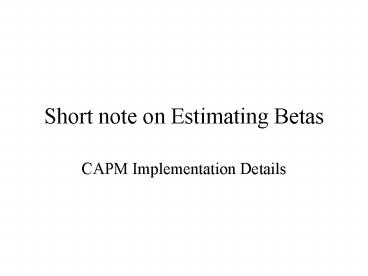Short note on Estimating Betas
1 / 8
Title:
Short note on Estimating Betas
Description:
alpha. From your statistics course. The Properties of Beta ... alphas should be zero in expectation. But in any sample of data, realized alpha will differ ... –
Number of Views:48
Avg rating:3.0/5.0
Title: Short note on Estimating Betas
1
Short note on Estimating Betas
- CAPM Implementation Details
2
Excess return on your stock
Excess return on the market
On average, excess return on your stock should
equal beta times excess return on the market
3
Estimating beta
Monthly excess return on your stock
Monthly excess return on the SP 500
4
From your statistics course
5
The Properties of Beta
- Portfolio b is linear in the components.
- Ex For a 50-50 portfolio, with one stock having
b.6 and the other having b.8. The portfolio
has b.7. - The portfolio mean also has this property, while
standard deviation doesnt. - For the mathematically inclined this is because
b is proportional to covariance, and covariance
is linear. - The b of the market portfolio is 1
6
Hows your confidence?
- Recall that I said
- Confidence intervals for means are huge
- You cant estimate the mean of anything
- Lots of variation in realized stock returns
- This is not true for higher moments
- We can estimate variance and covariance
relatively precisely. - We can be relatively confident of our estimates
of betas, but not alphas.
7
Alpha
- ( Excess return that is not explained by
movements in the market.) - If the CAPM is correct, and if markets are
efficient - alphas should be zero in expectation
- But in any sample of data, realized alpha will
differ wildly from zero (either or ) - Active portfolio management is all about the
search for alpha - Go visit Dr. Bob Litterman
8
A detail
Excess return on your stock
Excess return on the market
So technically you should be estimating.
For high-frequency data (i.e. day, week, month)
the risk-free rate is very small and very stable,
so there is little change to beta from estimating
Practical application for Homework 5, just use
raw returns.






![NOTE:%20To%20appreciate%20this%20presentation%20[and%20ensure%20that%20it%20is%20not%20a%20mess],%20you%20need%20Microsoft%20fonts:%20%20](https://s3.amazonaws.com/images.powershow.com/P1247176264UDuye.th0.jpg?_=201805141011)


![NOTE: To appreciate this presentation [and ensure that it is not a mess], you need Microsoft fonts:](https://s3.amazonaws.com/images.powershow.com/P1251921446IDPTU.th0.jpg?_=202011300810)
![NOTE:%20To%20appreciate%20this%20presentation%20[and%20insure%20that%20it%20is%20not%20a%20mess],%20you%20need%20Microsoft%20fonts:%20%20](https://s3.amazonaws.com/images.powershow.com/P1252428420wZXYW.th0.jpg?_=20180601048)














![NOTE: To appreciate this presentation [and ensure that it is not a mess], you need Microsoft fonts:](https://s3.amazonaws.com/images.powershow.com/5528768.th0.jpg?_=202007270510)
![NOTE: To appreciate this presentation [and ensure that it is not a mess], you need Microsoft fonts:](https://s3.amazonaws.com/images.powershow.com/5816511.th0.jpg?_=20200718068)
![NOTE: To appreciate this presentation [and insure that it is not a mess], you need Microsoft fonts:](https://s3.amazonaws.com/images.powershow.com/6149183.th0.jpg?_=20200721077)
![NOTE: To appreciate this presentation [and ensure that it is not a mess], you need Microsoft fonts:](https://s3.amazonaws.com/images.powershow.com/6577720.th0.jpg?_=20150513116)
![NOTE: To appreciate this presentation [and insure that it is not a mess], you need Microsoft fonts:](https://s3.amazonaws.com/images.powershow.com/7010443.th0.jpg?_=20150809053)

